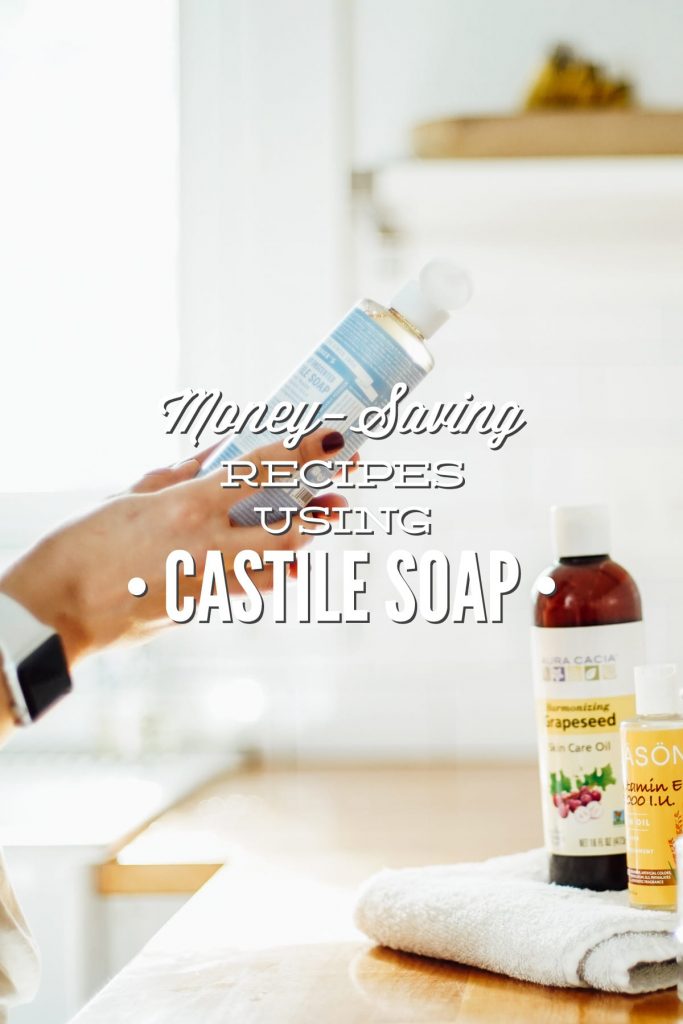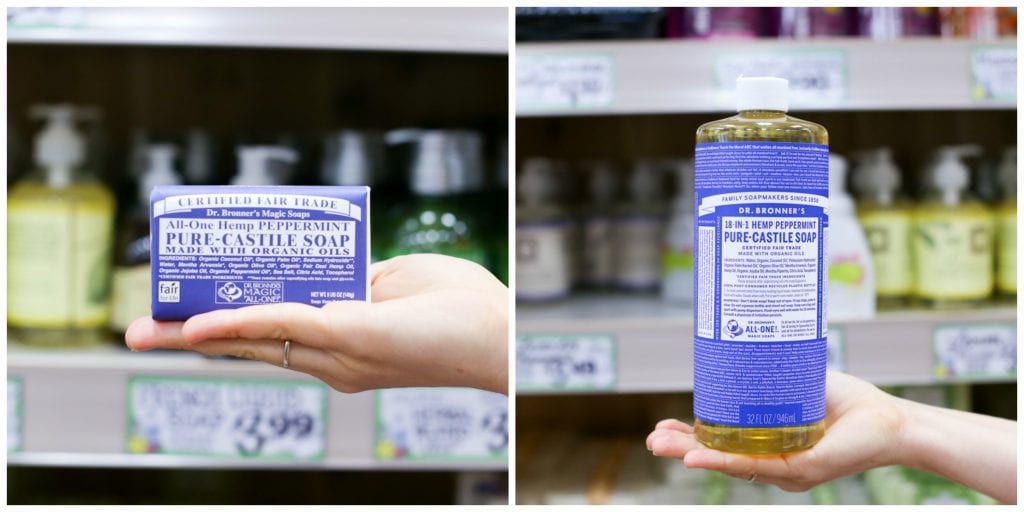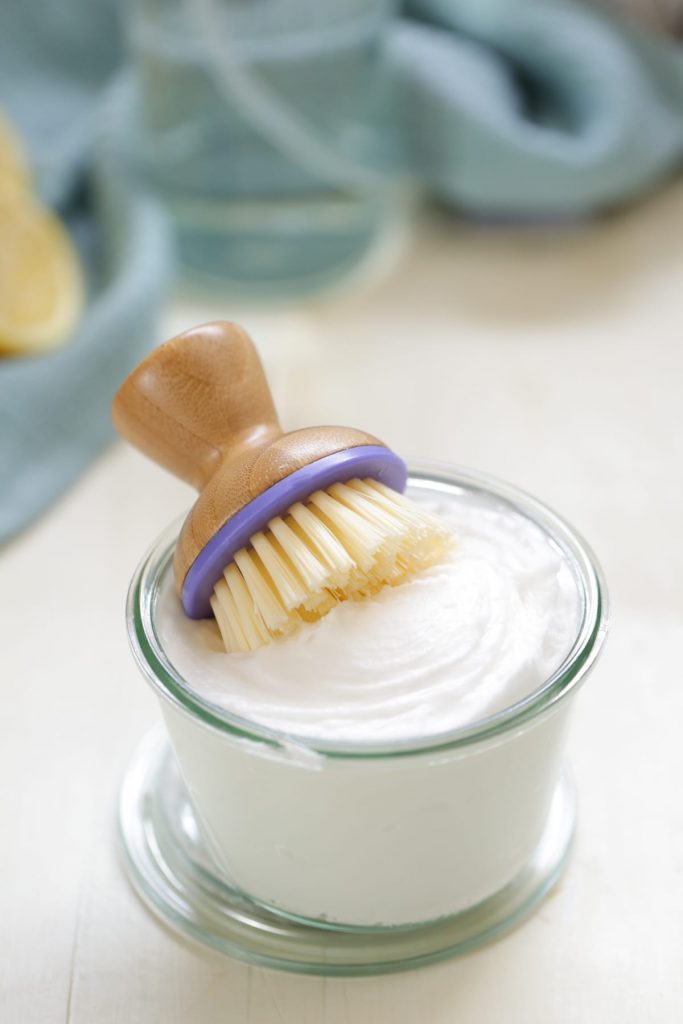How many different bottles of cleaning and beauty products sit under your kitchen sink right now?
If you peeked under my sink a few years ago, you would have counted at least 12 “different” products. I never sat down to calculate how much money I spent on all those products (most of which I didn’t use), but I’m sure the annual cost was quite significant.
After making changes to the way we eat (going from a diet of highly processed food to one of healthy, real food), I started to question the cleaning products used in home. I was curious (just as I was about food): what ingredients were used to create my favorite cleaning products? Why did my favorite beauty products smell a certain way? What ingredients were used to make the products sprayed in my home and layered on my body and were they safe? I also started to question whether so many different cleaning products were essential.
I was shocked to learn that cleaning and body products are not required go through rigorous testing or approval. In fact, cleaning companies are not required to disclose their ingredients (beauty product are required).
When you take a deep dive into researching these products and ingredients, it can be concerning to read about the impact they have on the body. For example, “fragrance” is considered a trade secret that is commonly found on the ingredient list (if disclosed) of products. This ingredient (which can be made with hundreds of different chemicals, including phthalates which disrupt hormones) is top secret and incredibly concerning in terms of toxic ingredients. This is just one example of the concerning ingredients that can be used to make a product.
Sure, maybe a small amount of these ingredients aren’t harmful (as companies say), but when you consider how many products we use in a day (or week or month), we aren’t using a trace amount of these chemicals in our homes and on our bodies. We’re burdening our systems with all these ingredients and the cumulative effect of using so many potentially-toxic chemicals.
You’ll find a lot of natural and green marketing words used to describe cleaning and body products today. These terms have no regulation, so full transparency of ingredients is all we have to help us navigate products and make informed choices.
A company should be completely transparent about their sourcing and ingredients, particularly a company that claims (on a website or packaging) to be “natural” or “non-toxic.” There should be nothing to hide. Instead, such a company should be proud to disclose their ingredients. This includes companies making both body and cleaning products.
At the time (remember, this was 9 years ago), there weren’t many transparent brands on the market making ready-to-use, multi-purpose cleaning products, so I decided to research the idea of making my own products. My research led to the discovery of a natural product that cleans anything and everything: castile soap.
What is Castile Soap?
Castile soap is a plant-based soap made from vegetable oils (olive, coconut, palm) and plant oils. Here’s the exact definition and ingredient list from Dr. Bronner’s (a popular castile soap brand).
“Castile soap is a concentrated vegetable-based soap with easy to recognize ingredients:Water, Organic Coconut Oil, Potassium Hydroxide, Organic Palm Kernel Oil, Organic Olive Oil, Lavandin Extract, Organic Hemp Oil, Organic Jojoba Oil, Lavender Extract, Citric Acid, Tocopherol.”
Want to learn more? In this guide, learn everything you need to know about this traditional soap, how to use it, 7 amazing benefits, the best brands, and warnings.
History of Castile Soap
Castile soap isn’t a new fad. It’s been around since the 11th century and was first made in the Aleppo of the Levant region (modern day Syria). The Crusaders learned about this soap which was, eventually, duplicated in Europe without success. That is, until a region in Spain (called Castile) was able to get the recipe right and successfully made what we know today as “castile soap.” The soap became popular with Spanish royalty and eventually by the 1500’s made its way to England.
3 Reasons to Use This Soap
Besides being an ancient and traditional soap, there are several reasons why castile soap is awesome…
- Super Versatile: Castile soap is super versatile. You can make cleaning and body products with the same soap.
- Inexpensive: A 32-ounce bottle of castile soap will cost $17. Yes, this is more expensive than a bottle of all-purpose cleaner, but it will last you for months! Castile soap is highly concentrated so a little bit goes a long way.
- Non-Toxic: Castile soap is made with easy to recognize, simple, non-toxic ingredients. This is why you can use it on your skin and the surfaces in your home.
How to Use Castile Soap
When using castile soap to make household cleaners, there are a few things to keep in mind…
- Dilute: Castile soap isn’t meant to be used as-is, unless you’re buying the bar soap for your body. It’s intended to be diluted before use. This chart is a great cheat sheet.
- Don’t Mix Castile Soap with Vinegar: I see this all the time on Pinterest. Please do not mix your castile soap with vinegar. You will not make an amazing cleaner. You’ll end up with a mess. When combined, vinegar (an acid) and castile soap (a base) cancel each other and create unsaponified soap. This reaction reduces the soap back to its original oils. If you try mixing the two ingredients you’ll immediately notice the castile soap curdles and feels very oily.
- Castile Soap is Safe for Most Surfaces: Unlike vinegar (which shouldn’t be used on marble or granite or unsealed wood), castile soap is safe to use on most surfaces in your home. The only one caution I would advise is to avoid using castile soap on waxed floors to avoid build-up.
- Castile Soap is Skin Safe: It’s not only safe for most surfaces, but also safe to use on the skin. Just be sure to dilute.
Where to Buy Castile Soap
You’ll find castile soap in most stores, from Target to Walmart to Whole Foods and the down-the-street grocery store. Many times, castile soap won’t be found in the cleaning section, so be sure to check the body care section. You can also buy castile soap on Amazon.
I recommend Dr. Bronner’s brand. I’ve tried other brands in the past, but haven’t been pleased with most options. Dr. Bronner’s makes several options for scents. I prefer the baby mild since I can add my own essential oils (for scent or additional antibacterial properties) or just go free of any scent. If you want to try a scented castile soap (the scents are completely natural and not made with the hormone disrupting ingredients found in “fragrance”), here’s what I recommend…
For cleaning products: Lavender, Tea Tree or Citrus
For beauty products: Lavender, Tea Tree or Baby Mild
7 Money-Saving Recipes Using Castile Soap
I don’t make all of these products today (9 years after I learned about castile soap and started making products at home). There are quite a few store-bought options now on the market, so most of my skincare is from brands I love and trust. I still make the most of my own cleaning products with laundry soap being the one exception. I find that making my own cleaning products to be the most affordable option for natural cleaning.
This list is to give you an idea of all the different products you can make with one bottle of castile soap. Using this one ingredient to make multiple products saves money and allows you to know exactly what’s going into your products.
1. All-Purpose Cleaner Spray
My favorite cleaning product that will clean nearly every surface in your home. Use this cleaner in your bathroom and kitchen, your sinks, stovetops, even your toilets.
- 2 cups distilled water
- 2 TB liquid castile soap
- 15 drops essential of choice, such as: lavender, tea tree, orange, or peppermint
- 16-ounce glass spray bottle
Pour the water into the spray bottle (use a funnel, if needed). Add the castile soap and essential oil. Gentle shake the cleaner. This cleaner may be stored at room temperature.
2. Hand Soap
With two active kiddos we go through a lot of hand soap in our house. A bottle of natural hand soap costs $3.99-$6 a bottle, depending on the brand. One 32-ounce bottle of castile soap makes approximately 8 homemade bottles of hand soap. If you don’t like the liquid feel of this hand soap, use a foaming hand soap dispenser instead of a regular soap dispenser.
- 1/2 cup distilled water
- 1/2 cup liquid castile soap
- 1 TB sweet almond oil, grapeseed oil, avocado, or olive oil (optional, for moisturizing)
- 15 drops tea tree essential oil (optional, for bacteria-fighting properties)
- 5-10 drops lavender essential oil (optional, for bacteria-fighting properties)
- soap dispenser or foaming soap dispenser bottle
3. Laundry Soap
This homemade laundry soap is made with just a few basic ingredients: (bar) castile soap, borax, and washing soda. Yes, this is a powdered laundry soap. If you prefer a liquid soap, I recommend this recipe.
-
- 2-5 ounce lavender castile soap bars, or any scent variety desired
- 3 cups washing soda
- 2 cups borax
- lavender essential oil, optional, or other oil, such as: tea tree, lemon or orange
Cut the castile soap bars into small slices or chunks. Place the castile soap slices or chunks in a food processor bowl. Pulse the soap on high until the soap resembles large crumbs. Add the washing soda to the food processor. Place a towel over the top of the food processor lid, and pulse for 1 minute. After pulsing, the ingredients should be well combined. If you don’t have a food processor, use a cheese grate and then mix the ingredients in a bowl. Pour the washing soda and castile soap into a storage container and stir in the borax. Add the essential oils, if using.
4. Soft Scrub-Like Cleaner
Need to scrub your bathtub or the kitchen sink? This scrub is the best! It will leave your tub and sinks sparkling like new.
- 1 cup baking soda
- 1/4 cup castile soap
- 1 TB hydrogen peroxide (if you’re storing this scrub for long-term use, don’t use this ingredient)
- large jar with a lid
In a medium-size bowl, combine the baking soda, castile soap, and hydrogen peroxide. Stir until the scrub cleaner looks like thick glue. Spoon the scrub cleaner in a large jar with a lid. Seal the jar. This cleaner will harden when exposed to air for a prolonged period of time. The scrub cleaner can be used immediately and kept at room temperature (in a sealed jar) for several months.
5. Bathroom Cleaner
This inexpensive homemade bathroom cleaner combines the power of castile soap, baking soda, water, and disinfecting oils. One 32-ounce bottle of castile soap makes approximately 16 bottles of germ-fighting bathroom cleaner.
- 2 cups warm water
- 1 TB baking soda
- 2 TB castile soap
- 30 drops tea tree essential oil
- 20 drops orange essential oil (or lavender)
- 16-ounce glass spray bottle
Pour the warm water into the bottle, followed by the baking soda. Shake the bottle to combine the ingredients. Add the castile soap and essential oils, gently shaking the bottle to combine. Use this spray to clean the tub, tile, toilet, and sink. Spray the surface, allow the cleaner to sit for a minute, then wipe with a damp cloth. Rinse the cloth as needed.
6. Body Wash
One 32-ounce bottle of castile soap will make multiple bottles of homemade body wash.
- 1/2 cup rosewater or distilled water
- 1/3 cup witch hazel (or just more water)
- 2 TB liquid castile soap
- 1-2 TB almond or olive oil (optional for moisturizing)
- foaming soap dispenser
Combine all the ingredients in a foaming soap dispenser, adding the castile soap as the last ingredient. Gently shake the bottle, with the top on, to combine the ingredients.
7. Face Wash
If you want to make your own face wash, using castile soap as the base is a great way to do this. One 32-ounce bottle of castile soap makes approximately 10 bottles of homemade face wash. You can customize this recipe to your liking so I’ll provide you with the base recipe here and then recommend going to this post to see all the customizations options.
- 1/4 cup liquid castile soap
- 2 TB distilled water
- 1 TB sweet almond oil, olive oil, or jojoba oil
- soap dispenser
More Ways to Use Castile Soap
Here are a few more ideas for how to use a bottle of castile soap…
- Makeup Brush Cleaner: Clean your makeup brushes and rid them of bacteria with this easy castile soap based cleaner.
- Floor Cleaner: Castile soap makes a great floor wash.
- Makeup Remover Wipes: Make your own makeup remover wipes with castile soap.

























Hi Kristin! Thanks so much for sharing your pearls of wisdom with us! I am really excited to get started on the different Castile Soap recipes, and I have a question: I notice you are adding, water, carrier oil, and essentials oil with the castile soap in some of your formulations. I am wondering if I need to you use a solubilizer to keep the ingredients combined or does the castile soap itself act as one. Also, since water and oil are being combined and there is no alcohol present, would you recommend adding a preservative to the mixture to keep little baddies from forming?
Hey Jess, You’re welcome. I’m glad they’re helpful! I choose to make small batches and use them quickly, so no need preservative is needed in that case. If you want to make a cleaner with oil and water and store it for weeks and months, then a preservative is recommended. I don’t add a solubilizer. Mixing the formula before use is my method. I want to keep everything super simple, so this is my preferred route and it’s effective for what I need at home.
The distilled water is extremely important for those of us who live in the southwest with hard water – using Castillo soap with hard water can result in soap scum residue.
So i just bought the Castile soap in the bar form, i know to make it, you grate then boil and mix together but does that then make it not concentrated? how do I convert the measurements? Very excited to try!!
Hey Renae, I don’t believe this would be concentrated, depending on amount of water used to make the liquid soap, but I could be wrong. I wouldn’t dilute once in liquid form, just use as-is, if a lot of water was used to convert it. Test it out. If you’re finding it’s too thick, or leaving behind a film on surfaces, dilute it with more water to make products.
How much of the powdered laundry soap do you recommend per load?
Hey Patti, I use 2 TB up to 1/4 cup.
Want to know essential oil can mix with hydrosol and Castile soap?
No preservatives?
Hey Shaheryar Ali, Yes, just use distilled water and use it quickly.
Can you make this antibacterial by putting alchohol in it? I love this soap. Just want it to be antibacterial as well for some cleaning and such.
Hey Becky, You could try. I don’t think it would hurt the soap, but may be drying on your hands. Just a good rub of the hands under hot/warm water with this soap should be good enough.
Thank you so much for these beautiful recipes! Is it ok to use the liquid hand soap recipe…the 1/2 castile to 1/2 water plus essential oils for a body wash not just hand wash? Thank you!
Does your Body Wash separate? Do you have a recipe for a body wash that can incorporate Essential Oils?
Hey Emily, It will separate, most natural products without an emulsifier will. Just shake to combine. You can add essential oils to that body wash. Just a few drops.
Is it safe to assume that TB means tablespoon? Most people use tbsp.
Hey Erik, Yes, correct.
I’m 55, took home Ec in HS, been baking since I was 10 years old, never seen TB…We were taught T for tablespoon, t for teaspoon.
To each their own.
a lot of your ingredients are crossed out – is that because the links are dead or because you don’t use that ingredient anymore?
TIA
Hey Davette, I apologize, that’s because at one point the links were broken, even if for just a minute. They’re all still good and active.